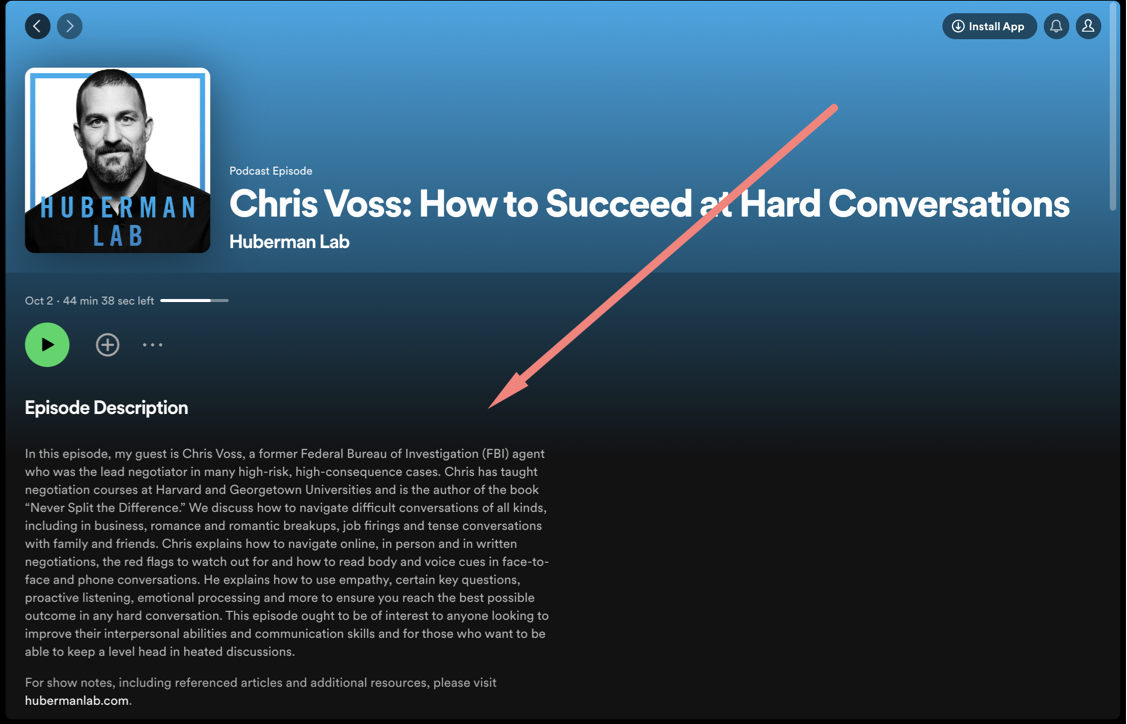
Podcast Descriptions 101 (Examples & Templates Included)
2023-10-09
In a fast-paced world, listeners appreciate a well-crafted summary that immediately conveys the essence of your episode.
In this post, we'll delve deep into the art of creating compelling podcast descriptions, showcasing examples from top podcasts, and providing a foolproof template. Additionally, you'll learn about common pitfalls to sidestep.
Elements of an Effective Podcast Description
Episode Highlights
Outline the main topics or themes of your episode, offering listeners a snapshot of what they can expect.
Whether it's an intriguing mystery, an enlightening interview, or a deep dive into a specific subject, highlighting key content elements will spark curiosity.
Guest Information (if applicable)
Include brief details about the guest's expertise or background. This enhances the appeal of the episode and provides recognition and appreciation for your guest's contribution.
Social Media Links
Providing links to your podcast's social media profiles invites listeners to join a larger community. It's a way for them to participate in discussions, share feedback, or stay updated on future episodes.
Call to Action
Whether you're encouraging listeners to subscribe, review, or share the podcast, a call to action is the way to do it.
It reminds listeners to interact and support your podcast.
3 Podcast Description Examples
Let's look at three different podcast descriptions.
Crime Junkie
First off is Crime Junkie's podcast description:


With Crime Junkie's podcast description, you immediately notice they've got it figured out. Their episode breakdown is detailed but not overwhelming. They use bold text intermittently, which is a smart touch, making it easy to spot the main takeaways.
Crime Junkie also includes a link leading straight to their official website. Perfect for anyone looking to deep dive or get a bit more context on a riveting case. It's a way to give fans an extra way to engage.
Finally, Crime Junkie uses direct links to their platforms so that listeners can share theories, debate details, or just rave about their latest episode.
Daily Stoic
The next podcast we'll look at is Daily Stoic.

The Daily Stoic podcast description keeps things succinct, but its brevity is a benefit, making it so that the listener/reader isn't overwhelmed. However, there's room for improvement. That slightly longer second paragraph? Breaking it up more could make it more digestible for quick scrollers.
The podcast description also has a direct link to the Daily Stoic newsletter. It’s a clever move, drawing listeners into a deeper engagement, offering them a chance to continue their stoic journey beyond just the podcast episodes.
For the fans who love to show their support, there's a handy link to their online store. Merchandise is a great way to resonate with your community, and by integrating it into the description, they're making it super accessible for listeners.
The Tim Ferris Show
Let's look at one more podcast description for a very popular podcast, The Tim Ferris Show.



The podcast description for The Tim Ferriss Show is much longer than the previous two podcast descriptions we've looked at. That's because this one includes much more information about the podcast sponsors.
This structure ensures the narrative flows while also spotlighting key partners, showing how podcast owners can have the best of both worlds.
Speaking of monetization, the description also includes a link to buy Tim's books. That's smart monetization in action. Without being too pushy, it offers fans another layer of engagement and learning.
Probably the most intriguing feature is the innovative way Tim promotes other podcasts. By hyperlinking the names of previous guests, he’s not just promoting episodes — he's offering listeners a more personalized journey. Let's say a listener is intrigued by Jerry Seinfeld. They would just click on his name, and voila, they'll be directed to the episode featuring him. It's an intuitive, user-friendly touch that enhances the listener's browsing experience.
Template for Creating Engaging Podcast Descriptions
[Introduction - Write 2-3 sentences introducing what your podcast is about. This is the hook that will grab listeners' attention.]
[Guest info - Share a brief bio of the speaker(s). Mention any credentials or experiences that make you an authority on the subject.]
[Call to Action - Encourage the listener to subscribe, rate, or review your podcast.]
[Connect With Us - Include social media handles and where listeners can reach out to you.]
Advanced Tips for Podcast Descriptions
Using Hashtags
While not all podcast platforms support hashtag functionality, when they do, it can be a valuable tool.
Relevant hashtags can improve discoverability, especially when listeners search for specific content themes or topics.
Leveraging Social Proof
There's power in numbers and testimonials. Did a listener leave a rave review? Or maybe a notable personality praised your episode?
Such endorsements act as a seal of trust, often persuading potential listeners to hit 'play.'
Keep it Short and Sweet
While it's tempting to share every detail, less is often more.
A concise, well-crafted description can be far more effective than a lengthy one.
Aim for clarity and punchiness, ensuring that the listener can grasp your episode's essence in just a few seconds.
Common Mistakes to Avoid in Podcast Descriptions
Overloading with Buzzwords
Buzzwords can seem appealing - they might come across as trendy or in-the-know. However, overloading your podcast description with buzzwords can be detrimental for several reasons:
Reduced Authenticity: While you aim to impress, packing a description with buzzwords can come across as insincere or as trying too hard.
Alienation of Audience: Not everyone is familiar with the latest jargon. Overusing buzzwords can alienate potential listeners who don't understand them.
Poor SEO Performance: Search engines prioritize clarity and user relevance. A description filled with buzzwords might not rank as well if it's not clear and relevant to potential listeners.
Instead of buzzwords, focus on a concise description. Highlight its value proposition, main topics, and why someone should tune in.
Using a Passive Voice
The Mistake: Crafting sentences where actions appear to happen without a clear actor or agent. For example, "The mysteries of the universe are explored in our podcast" rather than "We explore the mysteries of the universe."
The Fix: Active voice makes your description more direct and dynamic. It captures attention and conveys enthusiasm, making it clear who is doing what.
Forgetting Platform-Specific Limitations
The Mistake: Overlooking character limits, formatting rules, or other specific requirements that different podcast platforms might have.
The Fix: Familiarize yourself with the guidelines of each platform you publish on. Whether it's character limits or optimal hashtag use, adhering to platform-specific requirements makes it so your description displays correctly and effectively across all outlets.
Wrapping Up
When it comes to podcast descriptions, every detail matters in setting it apart from the competition. Yours can significantly influence listener engagement and audience growth.
As you understand and master its components, and avoid common pitfalls, podcasters you'll create narratives that draw listeners in.
FAQs About Podcast Descriptions
Why are podcast descriptions important?
Podcast descriptions act as a first impression, introducing potential listeners to the essence of your content. A well-crafted description can pique interest, showcase the podcast's value, and increase listener engagement.
What are podcast descriptions?
Podcast descriptions are concise summaries that give potential listeners an overview of what to expect from an episode or the podcast. They typically highlight key themes, guests, and calls-to-action.
How can I mention sponsors without making it sound spammy?
Transparency and authenticity are key. Rather than simply listing sponsors, integrate them organically into your description, like we saw in the example above with The Time Ferris Show. The way he does it makes it look like appreciation rather than a hard sell.
Can I include emojis in my podcast description?
Yes, emojis can be used to add personality and visual appeal, but use them judiciously. The Daily Stoic podcast description does a great job of this. Emojis should complement the text, not overshadow it.

Article by
Josh MayHey I'm Josh, one of the guys behind Show Notes Generator. I'm passionate about technology, podcasting, and storytelling.